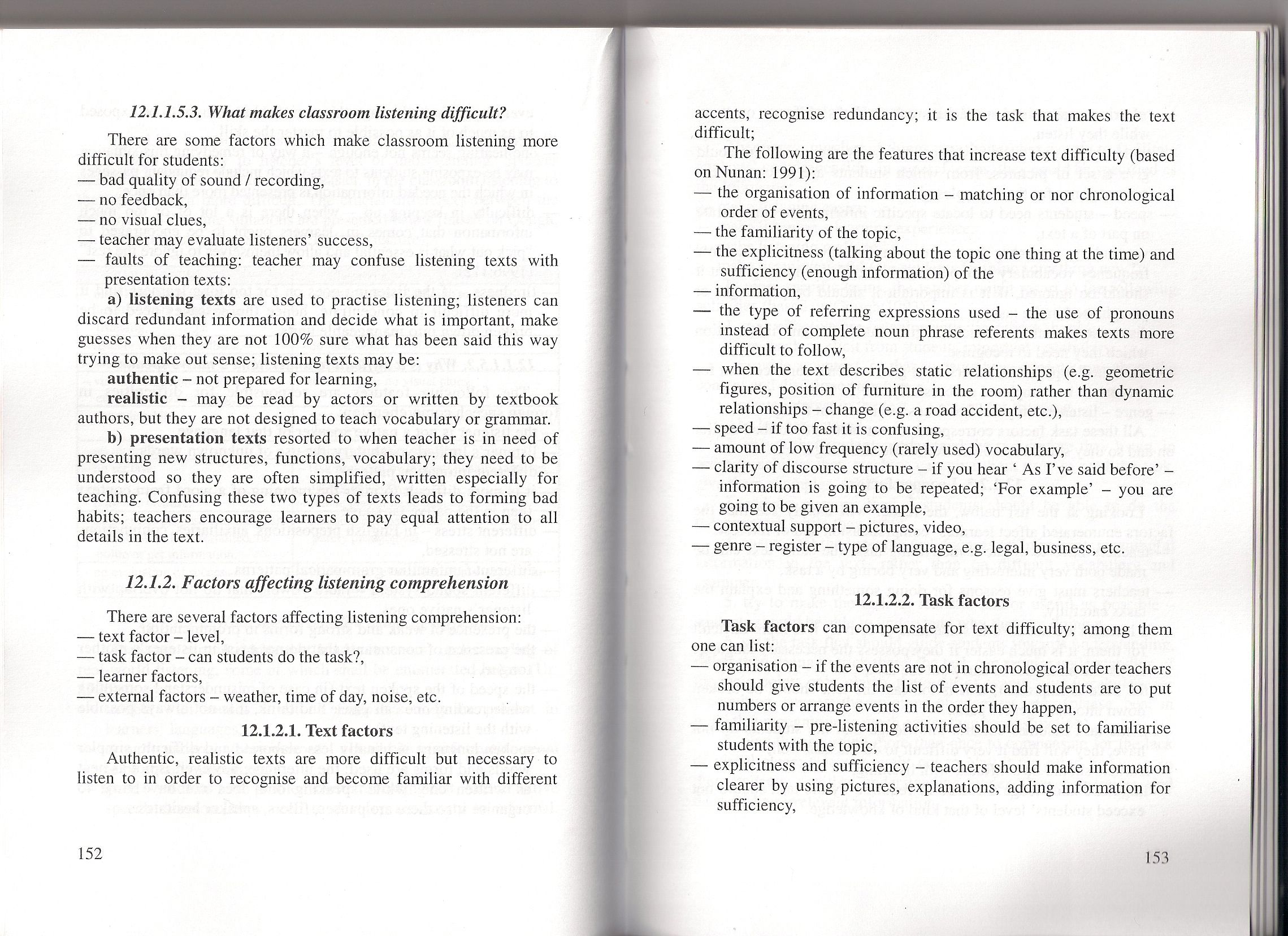skanowanie0076 (3)

12.1.1.5.3. What makes classroom listening difficult?
There are some factors which make classroom listening morę difficult for students:
— bad ąuality of sound / recording, s no feedback,
— no visual clues,
— teacher may evaluate listenerś’ success,
— faults of teaching: teacher may confuse listening texts with presentation texts:
a) listening texts are used to practise listening; listeners can discard redundant information and decide what is important, make guesses when they are not 100% surę what has been said this way trying to make out sense; listening texts may be:
authentic - not prepared for learning,
realistic - may be read by actors or written by textbook authors, but they are not designed to teach vocabulary or grammar.
b) presentation texts resorted to when teacher is in need of presenting new structures, functions, vocabulary; they need to be understood so they are often simplified, written especially for teaching. Confusing these two types of texts leads to forming bad habits; teachers encourage learners to pay equal attention to all details in the text.
12.1.2. Factors affecting listening comprehension
There are several factors affecting listening comprehension:
— text factor - level,
— task factor - can students do the task?,
S- leamer factors,
— extemal factors - weather, time of day, noise, etc.
12.1.2.1. Text factors
Authentic, realistic texts are morę difficult but necessary to listen to in order to recognise and become familiar with different
accents, recognise redundancy; it is the task that makes the text
difficult;
The following are the features that increase text difficulty (based
onNunan: 1991):
— the organisation of information - matching or nor chronological order of events,
— the familiarity of the topie,
— the explicitness (talking about the topie one thing at the time) and sufficiency (enough information) of the
— information,
— the type of referring expressions used - the use of pronouns instead of complete noun phrase referents makes texts morę difficult to follow,
— when the text describes static relationships (e.g. geometrie figures, position of fumiture in the room) rather than dynamie relationships - change (e.g. a road accident, etc.),
— speed - if too fast it is confusing,
-— amount of Iow freąuency (rarely used) vocabulary,
— clarity of discourse structure - if you hear ‘ As Fve said before’ -information is going to be repeated; ‘For example’ - you are going to be given an example,
— contextual support - pictures, video,
— genre - register - type of language, e.g. legał, business, etc.
12.1.2.2. Task factors
Task factors can compensate for text difficulty; among them one can list:
organisation - if the events are not in chronological order teachers should give students the list of events and students are to put numbers or arrange events in the order they happen,
— familiarity - pre-listening activities should be set to familiarise students with the topie,
— explicitness and sufficiency - teachers should make information clearer by using pictures, explanations, adding information for sufficiency,
153
Wyszukiwarka
Podobne podstrony:
skanowanie0076 (3) 12.1.1.5.3. What makes classroom listening difficult? There are some factors whic
47005 skanowanie0074 (3) 12.1.1.1. Sub-skills of listening Listening can be divide
skanowanie0074 (3) 12.1.1.1. Sub-skills of listening Listening can be divided into
47005 skanowanie0074 (3) 12.1.1.1. Sub-skills of listening Listening can be divide
46943 skanowanie0016 (36) of the time, but also there are freąuent occasions when the students are s
Paweł Antonowicz broadly defined customer s service. There are Systems, however, which not only allo
image003 Secreis entrusłed ło a lew (AMORC) THERE are some things tbat caooot be generally
Postinstallation Setup and Testing After installing MySQL, there are some issues that you should add
A: Yes there are many organisations which wants to legalize soft drugs. In cities like Amsterdam you
autostretching0244 Your muscles contain a great number of tiny blood vessels or capillaries. Normall
skanowanie0075 (3) 12.1.1.5. Real Iife vs. classroom listening In real life listening is easier beca
skanowanie0075 (3) 12.1.1.5. Real Iife vs. classroom listening In real life listening is easier beca
skanowanie0075 (3) 12.1.1.5. Real Iife vs. classroom listening In real life listening is easier beca
skanowanie0103 (2) 12.4.3. Writing activities There are many different activities that students can
skanowanie0103 (2) 12.4.3. Writing activities There are many different activities that students can
więcej podobnych podstron